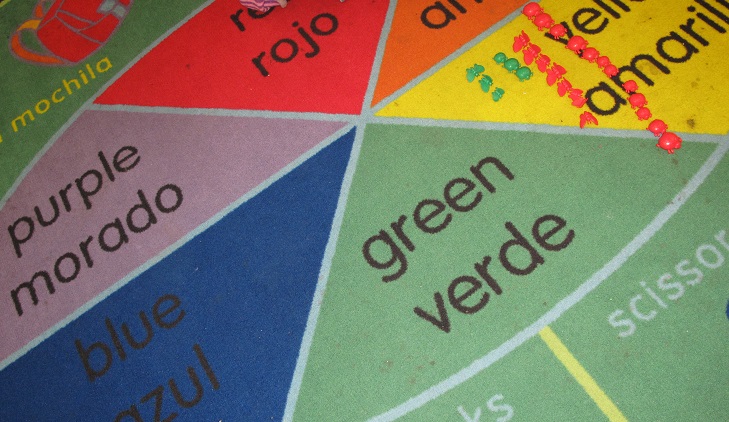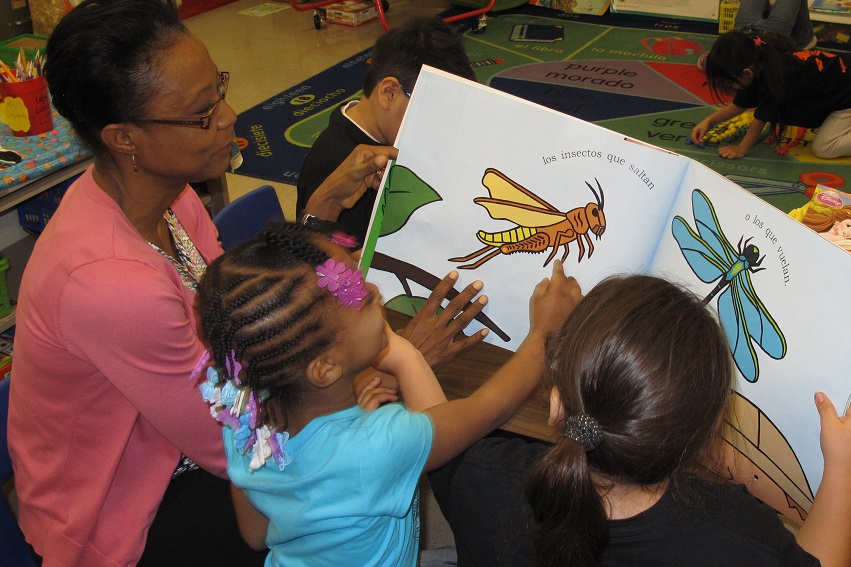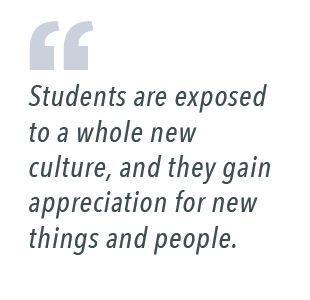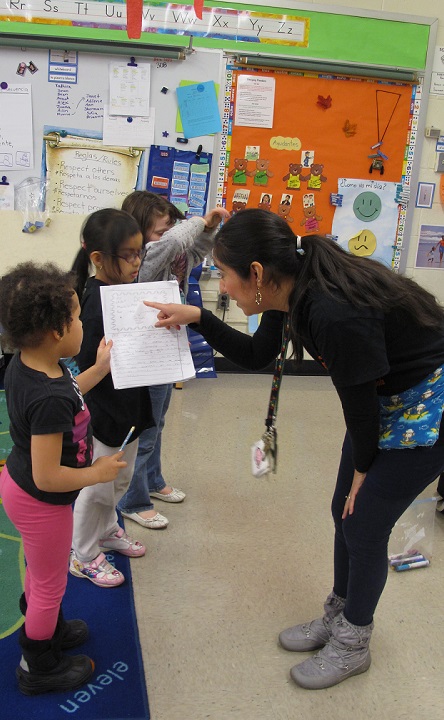Learning in English, aprendiendo en Español: Professor helps create a K-5 dual language program in local elementary schools
by Allie Pitcher and College of Education / Aug 1, 2013

When 5-year-old Garrett started kindergarten at Leal Elementary School in Urbana, he learned the usual kindergarten tasks: reading simple sentences, following class rules, socializing with his peers, and other skills appropriate for his age and grade level.
The only unusual thing about Garrett's experience is that he learned to do most of it in Spanish.
 With steady growth in the Spanish-speaking population across the nation, the Urbana School District has taken the lead in integrating both English and Spanish language into the classroom, and the College of Education's associate professor Eurydice Bauer played a major role.
With steady growth in the Spanish-speaking population across the nation, the Urbana School District has taken the lead in integrating both English and Spanish language into the classroom, and the College of Education's associate professor Eurydice Bauer played a major role.
When walking the halls at Prairie Elementary School in Urbana, the most visible clue that you've entered a dual language school is that all the signs throughout the building are in both English and Spanish. During the 2012-13 school year, the dual language model was taught in three of the 15 K-5 classrooms at both Leal and Prairie elementary schools, the first schools in the district to implement the program.
The program is voluntary, and the number of dual language classrooms at each grade level depends on the number of Spanish dominant and English dominant students who apply.
Innovative dual language program is offered under the direction of Eurydice Bauer
Bauer, a faculty member in the Department of Curriculum and Instruction (C&I), along with C&I Professor Georgia Garcia and Christina DeNicolo, now an assistant professor at Wayne State, led the way for the Urbana School District 116 to offer a dual language program for the  first time starting with the 2012-13 academic year. Bauer also worked closely with Joseph Wiemelt, Ed.M. '09 EOL, director of equity and student learning for the Urbana School District, and Prairie's principal Yavonda Smith, Ed.M. '05 EOL.
first time starting with the 2012-13 academic year. Bauer also worked closely with Joseph Wiemelt, Ed.M. '09 EOL, director of equity and student learning for the Urbana School District, and Prairie's principal Yavonda Smith, Ed.M. '05 EOL.
Wiemelt and Smith welcomed Bauer's expertise in biliteracy and bilingualism. "The program has been extremely successful and Dr. Bauer has been a key member of its success at Prairie Elementary School," Wiemelt said.
Bauer believes that learning a language is more than just picking up a few words, but instead, in the dual language program, students are exposed to a whole new culture and they gain appreciation for new things and people.
“We are trying to help the Spanish-speaking students to maintain the Spanish language and gradually add the English language. With our native English speakers, we want them to have a solid base in the Spanish language and immersion in Spanish in the early years," Bauer explained. "We believe this is the most effective way to develop bilinguals across both language groups." Beyond learning the language, she adds that the students are also learning about each other’s cultures.
Students hit the ground running
Students start the program in kindergarten and they continue the dual language curriculum until they finish fifth grade. For the first year teachers teach lessons using 90 percent Spanish and 10 percent English, and as the students continue with the program, the amount of Spanish in the classroom decreases. With that model, students in dual language programs develop high levels of proficiency in their first language as well as a second language. To facilitate learning and ensure that the classroom does not become too English dominant, the program strives for two-thirds Spanish speakers and one-third English speakers.
“What’s great is that all students, both Spanish-speaking and English-speaking, are being enriched and are reaching their academic goals.” Bauer said. “Everyone gets what they need from this program.”
Bauer, who speaks four languages and raised her own children in a bilingual household, adds that the process of becoming a balanced bilingual promotes creativity and problem solving as well as a greater cross-cultural appreciation.
Because of Bauer's linguistic/cultural background and research in biliteracy development in very young children, she is an ideal fit to partner with the school district. In helping to shape the program at Prairie, she worked closely with the dual language teachers at the school.
Throughout her career, Bauer's research projects have focused on alternative literacy assessment, biliteracy development, and preservice education. She has researched emergent literacy development across two languages and the literacy and assessment development of elementary school students (preschool to grade 5) from diverse linguistic and cultural backgrounds.
Kindergarten teacher Vivian Presiado says students soar in the program
Dual language teachers are all fluent in the Spanish language, and many, like Vivian Presiado of Prairie Elementary, learned Spanish as a first language. Presiado taught dual language for the first time in the fall of 2012 and saw a great amount of progress in the students.
“Our students moved at a rate that I never imagined possible,” said Presiado. “They understand everything that I say and if they don't, they know how to ask what it means.”
Like Bauer, Presiado believes that it is positive for students to have a second language under their belts and a better understanding of another culture for their life ahead.
“It's a good thing to know a second language or more and I think that the U.S. took a little longer to realize that. Urbana understands that it is a good thing to know a second language, and I think that’s a really great thing.”
Dual language bubbles over at home; one parent said she 'struck the jackpot'
Kindergarteners who have completed their first year in the program are already showing noticeable differences, even at home.
“Our son is proud that he knows Spanish, and he enjoys teaching us words he has learned,” said Garrett Bowersox-Johnson's father, Brandon.
Other parents like Evelyn Shapiro, whose children have grown up using Spanish at home, think that their children reap the same benefits as those who are only English speakers. Shapiro’s 5-year-old daughter was a kindergarten student at Leal Elementary in the dual language program, and Shapiro is very supportive of the new program.
Shapiro said her daughter thrives in the dual language environment, and that she has embraced the idea that she needs to speak in Spanish with both the teacher and her classmates.
“We are committed as a family to using Spanish, and I felt like we’d struck the jackpot to learn that the dual language program was being developed,” Shapiro said.
TOP PHOTO: Professor Eurydice Bauer with students in a Prairie Elementary School dual language classroom. MIDDLE PHOTO: Kindergarten teacher Vivian Presiado helping students.